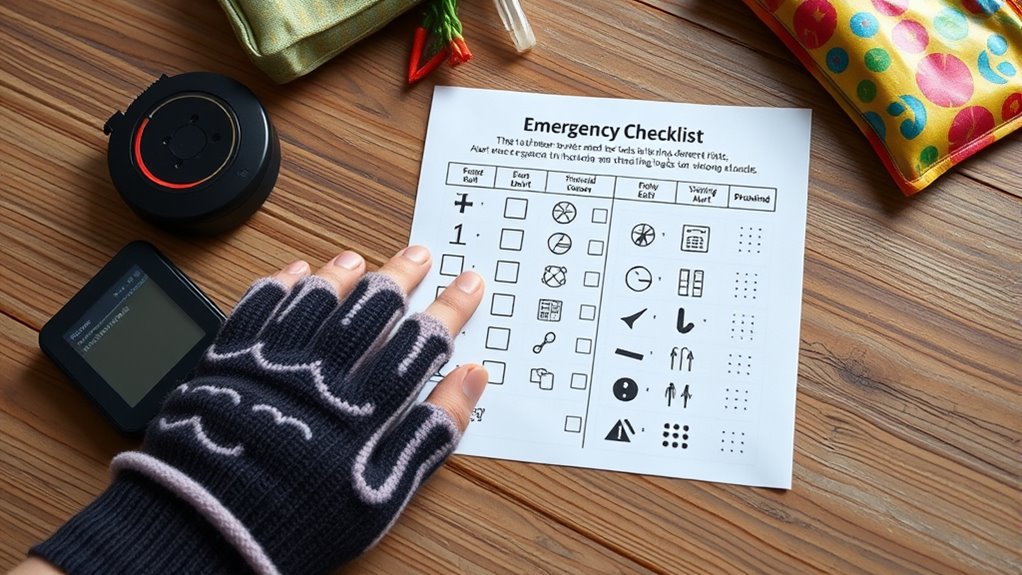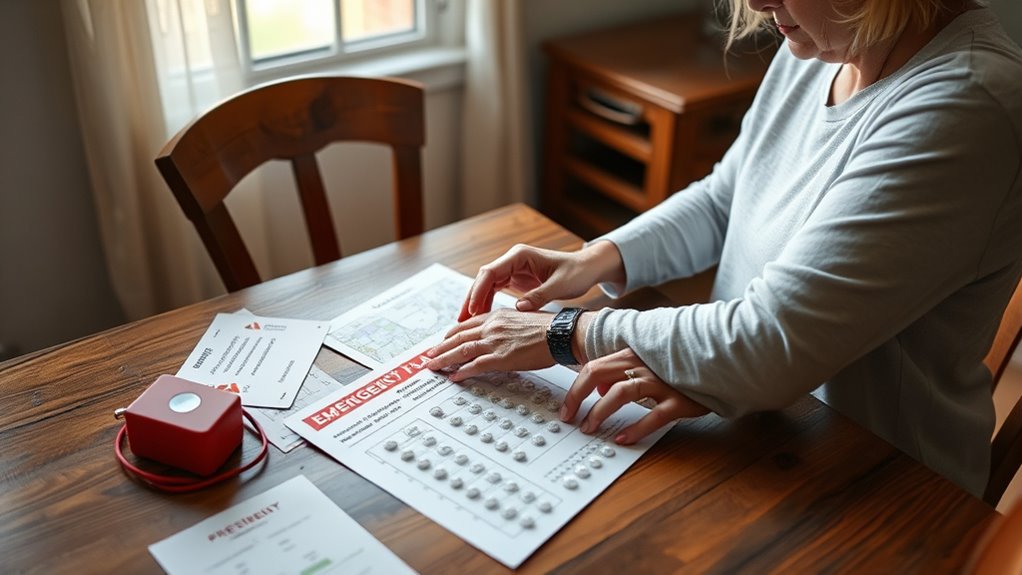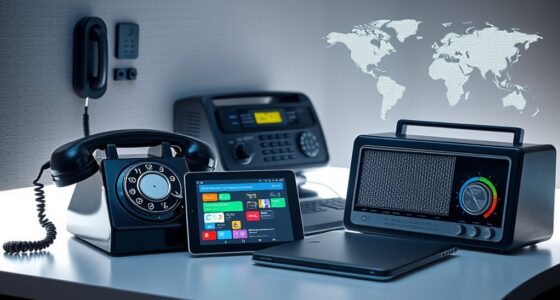To prepare for emergencies as a deafblind household, you should assess your specific risks and needs, like hazards, evacuation routes, and medical management. Develop accessible communication strategies with tactile methods or sign language, and create a tailored emergency plan considering mobility and sensory needs. Regularly practice drills and build support networks with neighbors and organizations. Staying informed and equipped guarantees you’re ready for any crisis—if you continue, you’ll discover more ways to stay safe and supported.
Key Takeaways
- Assess specific hazards and ensure accessible evacuation routes tailored to deafblind needs.
- Develop tactile and visual communication methods, including braille and vibrating alerts, for emergency messaging.
- Create a personalized emergency plan considering mobility, sensory adaptations, and availability of support resources.
- Conduct regular drills and first aid training to improve response confidence and identify potential obstacles.
- Build a support network with neighbors, organizations, and emergency services familiar with deafblind assistance.
Assessing Specific Risks and Needs

Understanding your household’s unique risks and needs is a crucial first step in emergency preparedness. You need to identify potential hazards in your environment, such as natural disasters or power outages, and consider how they could affect you. Evaluate your evacuation routes carefully; verify they are accessible and clear of obstacles. If you have medical needs, plan how to manage them during an emergency—this might include medication storage, mobility aids, or emergency medical devices. Consider how your deafblindness impacts your ability to receive alerts and assistance. By analyzing these specific risks and needs, you create a solid foundation for your emergency plan. This awareness helps you prepare effectively, ensuring safety and support tailored to your household’s unique circumstances. Additionally, staying informed about AI safety measures can help you better understand emerging technologies that might impact your safety during emergencies.
Creating Accessible Communication Strategies

Creating effective communication strategies is essential for guaranteeing that you receive and share critical information during emergencies. To do this, incorporate sign language skills or devices you’re comfortable with, enabling clear message exchange. Tactile communication methods, like hand-over-hand signals or braille, allow you to connect even when visual or auditory cues aren’t available. Keep communication tools accessible and updated, so you can quickly use them when needed. Practice these strategies regularly with family members or caregivers to build confidence and ensure everyone understands how to communicate effectively in a crisis. By establishing reliable, accessible methods, you minimize misunderstandings and stay informed, helping you respond swiftly and safely during emergencies. Additionally, understanding the horsepower of electric bikes can provide insights into energy efficiency and power needs for specialized equipment.
Developing a Customized Emergency Plan

Developing a customized emergency plan is essential to guarantee your safety and preparedness. Tailor your plan by considering sensory adaptations and mobility considerations to make sure it fits your specific needs. Identify accessible communication methods during an emergency, such as tactile alerts or visual signals. Map out your home and nearby safe zones, factoring in mobility challenges. Prepare sensory adaptations like textured markers or vibrating alerts to signal important information. Include detailed instructions for assistance during evacuations or emergency situations. Regularly update your plan to reflect changes in your environment or health. Practice your plan to build confidence and identify potential improvements. Incorporating emotional support strategies into your plan can help manage stress and foster resilience during emergencies. Your personalized approach ensures you’re ready to respond effectively, reducing stress and increasing safety during any emergency.
Training and Practice for Emergency Readiness

Practicing your emergency plan regularly helps guarantee you’re prepared when it matters most. Conduct evacuation drills to familiarize yourself with your chosen routes and procedures, ensuring you can act quickly in a real emergency. These drills help you identify potential obstacles and improve your response time. Additionally, learn basic first aid skills to handle injuries or medical emergencies until professional help arrives. Regular practice builds confidence and helps you remember critical steps, reducing panic during actual events. Incorporate drills into your routine, adjusting them as needed to account for different scenarios. By consistently practicing, you’ll ensure that everyone in your deafblind household knows their role, making your emergency response more effective and less stressful when it counts.
Building Support Networks and Resources

Building a strong support network is essential for guaranteeing help is available when you need it most. By connecting with neighbors, local organizations, and emergency services, you create a safety net tailored to your needs. Community outreach programs can introduce you to volunteers trained to assist deafblind individuals during crises. Utilizing technological solutions, like alert apps or vibrating alert systems, enhances communication during emergencies. Building relationships with first responders familiar with your situation ensures quick, effective assistance. Consider joining or forming local support groups to share resources and advice. Establishing these connections ensures you’re not isolated during emergencies and that help arrives promptly when needed most. A well-developed network offers peace of mind, knowing you’re supported by a community that understands your unique needs. Additionally, incorporating wall organization systems can help keep essential emergency supplies visible and accessible in your home.
Frequently Asked Questions
How Can I Find Local Emergency Services Familiar With Deafblind Needs?
You can find local emergency services familiar with deafblind needs by reaching out to organizations specializing in disabilities. Ask if they provide sign language interpretation and are equipped in assistive device compatibility. Contact your local fire and police stations directly, or visit their websites to inquire about their accessibility programs. Building a relationship with these services ensures they understand your needs and can respond effectively during emergencies.
What Technology Tools Are Most Effective for Deafblind Emergency Alerts?
Your emergency alerts need to be as clear as a thunderclap. Tactile alert devices are highly effective, vibrating intensely to catch your attention instantly. Smartphone accessibility features, like haptic feedback and visual alerts, also play an essential role. Combining these tools ensures you receive important alerts promptly, making safety feel like a comforting hug in a chaotic storm. Stay equipped with these technologies to stay safe and informed.
How Do I Update My Emergency Plan as Circumstances Change?
When circumstances change, you should review and update your emergency plan regularly. Focus on updating procedures to reflect new risks or resources, and revise communication strategies to guarantee they remain accessible. Keep your contact information current, and test new tools or methods to confirm they work effectively. Staying proactive helps you respond confidently, knowing your plan is tailored to your current situation and communication needs.
Are There Specific Legal Rights or Protections for Deafblind Individuals During Emergencies?
Did you know that deafblind individuals often face unique challenges during emergencies? Legal protections and emergency rights vary by location, but many laws guarantee accessible communication and safety measures for you. You have the right to receive information in accessible formats, like tactile or visual alerts, and to have assistance if needed. Knowing your legal rights helps you advocate for yourself and stay safe during emergencies.
How Can I Involve Neighbors or Community Members in Emergency Preparedness?
You can involve neighbors and community members through effective community outreach and volunteer coordination. Start by sharing your needs and safety plans, inviting them to participate in emergency drills or prepare supplies. Building relationships helps guarantee they understand how to assist during emergencies. Encourage open communication and offer guidance on supporting deafblind households, fostering a supportive network that enhances everyone’s safety and preparedness during emergencies.
Conclusion
As you finalize your emergency plan, you realize that the same dedication you put into understanding your unique needs often leads to unexpected moments of connection. Just like discovering a neighbor who shares your experiences, your preparedness efforts create a safety net built on trust and understanding. In those quiet, coincidental moments, you see how your proactive approach transforms uncertainty into confidence, turning a challenging situation into a demonstration of resilience and community.











